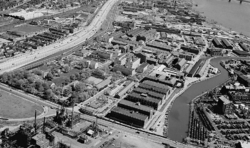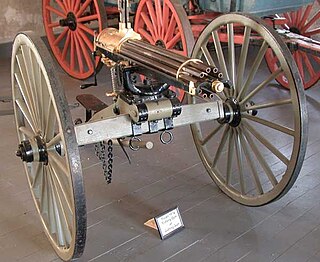
The Gatling gun is a rapid-firing multiple-barrel firearm invented in 1861 by Richard Jordan Gatling. It is an early machine gun and a forerunner of the modern electric motor-driven rotary cannon.
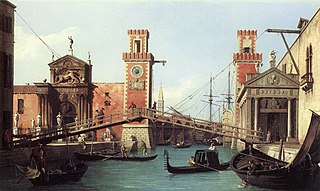
An arsenal is a place where arms and ammunition are made, maintained and repaired, stored, or issued, in any combination, whether privately or publicly owned. Arsenal and armoury or armory are mostly regarded as synonyms, although subtle differences in usage exist.

John TaliaferroThompson was a United States Army officer known for being the inventor of the Tommy gun.
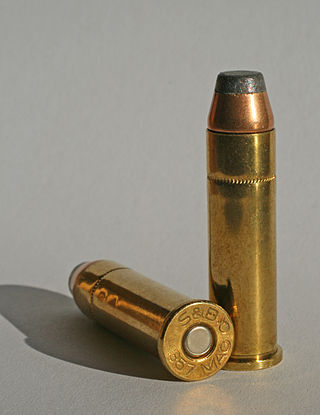
A center-fire is a type of metallic cartridge used in firearms, where the primer is located at the center of the base of its casing. Unlike rimfire cartridges, the centerfire primer is typically a separate component seated into a recessed cavity in the case head and is replaceable by reloading the cartridge.

The .45 ACP, also known as .45 Auto, .45 Automatic, or 11.43×23mm is a rimless straight-walled handgun cartridge designed by John Moses Browning in 1904, for use in his prototype Colt semi-automatic pistol. After successful military trials, it was adopted as the standard chambering for Colt's M1911 pistol. The round was developed due to a lack of stopping power experienced in the Moro Rebellion in places like Sulu. The issued ammunition, .38 Long Colt, had proved inadequate, motivating the search for a better cartridge. This experience and the Thompson–LaGarde Tests of 1904 led the Army and the Cavalry to decide that a minimum of .45 caliber was required in a new handgun cartridge.
The .30-06 Springfield cartridge, 7.62×63mm in metric notation, and called the .30 Gov't '06 by Winchester, was introduced to the United States Army in 1906 and later standardized; it remained in military use until the late 1970s. In the cartridge's name, ".30" refers to the nominal caliber of the bullet in inches; "06" refers to the year the cartridge was adopted, 1906. It replaced the .30-03 Springfield, 6mm Lee Navy, and .30-40 Krag cartridges. The .30-06 remained the U.S. Army's primary rifle and machine gun cartridge for nearly 50 years before being replaced by the 7.62×51mm NATO and 5.56×45mm NATO, both of which remain in current U.S. and NATO service. The cartridge remains a very popular sporting round, with ammunition produced by all major manufacturers.

The Type 26 or Model 26 "hammerless" revolver was the first modern revolver adopted by the Imperial Japanese Army. It was developed at the Koishikawa Arsenal and is named for its year of adoption in the Japanese dating system. The revolver saw action in conflicts including the Russo-Japanese War, World War I and World War II.

A headstamp is the markings on the bottom of a cartridge case designed for a firearm. It usually tells who manufactured the case. If it is a civilian case it often also tells the caliber: if it is military, the year of manufacture is often added.

The two most common assault rifles in the world are the Soviet AK-47 and the American M16. These Cold War-era rifles have been used in conflicts both large and small since the 1960s. They are used by military, police, security forces, revolutionaries, terrorists, criminals, and civilians alike and will most likely continue to be used for decades to come. As a result, they have been the subject of countless comparisons and endless debate.

The Picatinny Arsenal is an American military research and manufacturing facility located on 6,400 acres (2,590 ha) of land in Jefferson and Rockaway Townships in Morris County, New Jersey, United States, encompassing Picatinny Lake and Lake Denmark. The Arsenal is the headquarters of the U.S. Army Combat Capabilities Development Command Armaments Center. It is known for developing the ubiquitous Picatinny rail, as well as being the Army's center of expertise for small arms cartridge ammunition.

The origins of the modern British military rifle are within its predecessor the Brown Bess musket. While a musket was largely inaccurate over 100 yards (91 m), due to a lack of rifling and a generous tolerance to allow for muzzle-loading, it was cheap to produce and could be loaded quickly. The use of volley or mass firing by troops meant that the rate of fire took precedence over accuracy.

The Government Arsenal (GA) is an agency of the Philippine government under the Department of National Defense, responsible for the production of basic weaponry and ammunition for the Armed Forces of the Philippines (AFP) and the Philippine National Police (PNP).
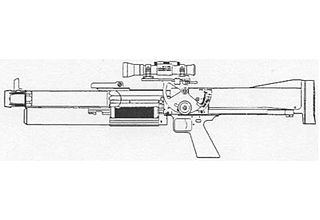
The EX 41 grenade launcher, also called the Shoulder-Fired Weapon (SFW), was a prototype multi-shot grenade launcher that was never adopted by the United States military. Most of its development was at Naval Ordnance Station Louisville for the US Marine Corps in order to replace the single-shot M203. NOS Louisville had previously developed the Mk 19 and Mk 20 multi-shot grenade launchers. The Picatinny Arsenal also aided in the EX 41's development as part of the Army's Bursting Munitions Technology program. In its final form, the EX 41 was intended to weigh as little as 6.8 kg and have a range of up to 1500 m. The program never progressed beyond a single prototype and in November 1995, the design was sent to Knight's Armament Company for further development.
The former Royal Ordnance Factory (ROF), Radway Green manufactures small arms ammunition for the British armed forces. It is located in the hamlet of Radway Green near Barthomley near Alsager in Cheshire in the UK.

Ammunition, also known as ammo, is the material fired, scattered, dropped, or detonated from any weapon or weapon system. Ammunition is both expendable weapons and the component parts of other weapons that create the effect on a target.

The M249 SAW, formally the Light Machine Gun, 5.56 mm, M249, is the United States Armed Forces adaptation of the Belgian FN Minimi, a light machine gun manufactured by FN Herstal (FN).
JSC Arsenal AD is a Bulgarian joint-stock company based in Kazanlak, engaged primarily in the manufacture of firearms and military equipment. It is Bulgaria's oldest arms supplier.
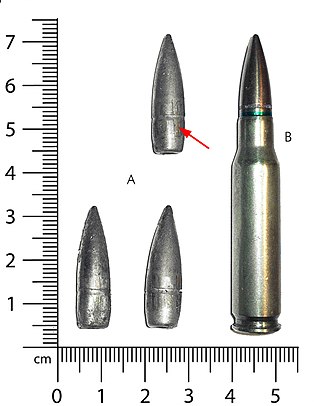
The 7.62×51mm NATO is a rimless, straight walled, bottlenecked, centerfire rifle cartridge. It is a standard for small arms among NATO countries.

Captain Henry Metcalfe was an officer in the United States Army Ordnance Corps, inventor and early organizational theorist, known for his 1873 invention of a detachable magazine for small arms, for his work on modern management accounting, the development of the "time card" and his theory on the role of middle management.
